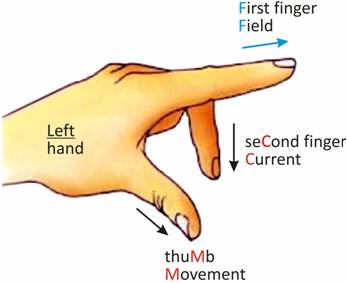Magnetic effect of current Worksheet-10
-
Why is the earth pin thicker and longer than the live pins ?
-
Vishal performs an experiment in lab to study the magnetic effect of current around a current carrying straight conductor. He reports that:
(i) the direction of deflection of the north pole of a compass needle kept at a given point near the conductor remains unaffected even when the terminals of the battery sending the current in the wire are interchanged.
(ii) For a given battery current, the degree of deflection of a N-pole decreases when the compass is kept at a point farther away from the conductor.
Which of these observations is correct and why ?
-
Why does a current-carrying conductor kept in a magnetic field experience force? On what factors does the direction of this force depend? Name and state the rule used for determination of direction of this force.
-
(i) What is the meaning of the term 'frequency' of an alternating current ?
(ii) Why is alternating current considered to be advantageous over direct current for long range transmission of electric energy ?
-
You are given following current-time graphs from two different sources ;

(i) Name the type of current in two cases.
(ii) Identify any one source for each type of these currents.
(iii) What is the frequency of current in case II in India ?
(iv) Use above graphs to write two differences between the currents in the two cases.
-
How can it be shown that a magnetic field exists around a wire through which a direct current is passing?
-
How is the strength of the magnetic field at a point near a wire related to the strength of the electric current flowing in the wire ?
-
An alternating electric current has a frequency of 50 Hz. How many times does it change its direction in one second?
-
What will be the frequency of an alternating current if its direction changes after every 0-01 s ?
-
What is short-circuiting in an electric supply ?
Answer:
-
The earth pin is made thicker so that it does not enter the live or neutral sockets. It is made longer so that it gets connected to the earth terminal earlier than the live and the neutral pins. This ensures the safety of the user as the earth will melt the fuse in case the electric appliance is short-circuited.
-
(i) This observation is incorrect because the direction of the magnetic field around a conductor changes with the change in direction of the current flowing through it, Due to this change in the direction of the magnetic field, the direction of force acting on the north pole of the compass also changes.
(ii) This observation is correct because the magnitude of the magnetic field decreases with an increase in the distance from the current carrying conductor.
-
The force on a current-carrying conductor in a magnetic field is due to interaction between :
(i) magnetic field due to current-carrying conductor and
(ii) the external magnetic field in which the conductor is placed. The resultant of these two magnetic fields is not uniform. It is weaker on one side of the conductor than that of the other side. The conductor, therefore, experiences a resultant force in the direction of the weaker magnetic field.
The direction of the force acting on the current-carrying conductor placed in the magnetic field depends upon :
(i) direction of the current through the conductor and
(ii) direction of the magnetic field in which the conductor is placed.
The direction of the force acting on the current-carrying conductor placed in the magnetic field is determined by using Fleming's Left Hand Rule

-
(i)The number of cycles completed by the AC in one second is called the frequency of AC.
(ii) The loss of electric energy is very low at very high voltage and as such transmission losses are minimized at very high voltage. At the receiving station, the high voltage can be stepped down to the desired value by using a transformer.
-
(i) Source I represents direct current (DC) whereas source II represents alternating current (AC)
(ii) Source I may be a dry cell or a voltaic cell and Source II is an AC Generator,
(w) Time period (T) of AC (Source II) is 0.03 s – 0.01 s = 0.02 s. Thus, the frequency of AC,
i.e., .
V =  = 50Hz
= 50Hz
(iv) (a) The magnitude of DC remains the constant whereas that of AC keeps on changing.
(b) The direction of DC remains the same whereas that of AC keeps on changing.
-
A compass needle placed near the wire, through which current is flowing, gets deflected, there by showing the magnetic field around it.
-
The strength (B) of the magnetic field at a point near a wire is directly proportional to the strength (I) of the current flowing in the wire i.e. B ∞ I.
-
Since AC changes its direction twice in a cycle, it will change its direction 100 times (= 50 × 2) in 1 second as its frequency is 50 Hz (it completes 50 cycles in 1 second).
-
Since AC changes its direction after every 0.01 s, it completes one cycle (i.e. changes its direction twice) in 2 × 0.01 = 0.02 s. It completes 50 cycles (1 s/0.02 s) in 1 second i.e. its frequency is 50 Hz.
-
Short-circuiting in an electric supply occurs when the live wire touches the neutral wire.


![]() = 50Hz
= 50Hz